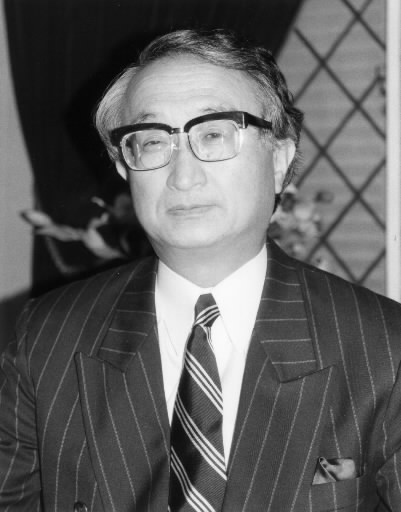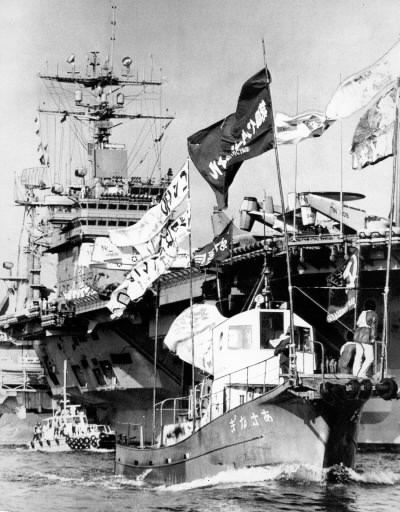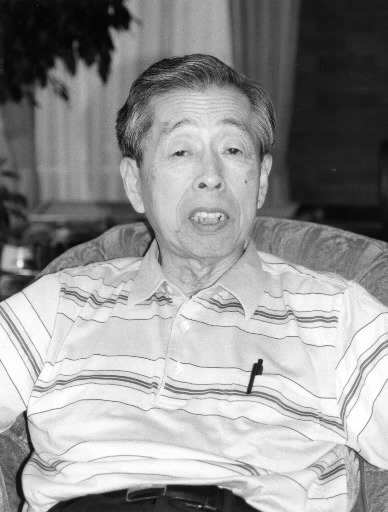History of Hiroshima: 1945-1995 (Part 26, Article 2)
Mar. 17, 2013
Non-nuclear policy
by Tetsuya Okahata, Staff Writer
Note: This article was originally published in 1995.
This summer Emperor Akihito and Empress Michiko will travel to Hiroshima, Nagasaki, and Okinawa to console the souls of the war dead. In this 50th anniversary of the war’s end, the trip seems to signify the royal couple’s intention to share in the historical burdens and suffering experienced by the Japanese people by visiting these sites that saw incredible devastation during the war.
Many Hiroshima citizens who endured the horrific consequences of the first nuclear attack in history still hold mixed feelings when it comes to the word “emperor.” Emperor Showa, however, visited Hiroshima six times, beginning with his first visit to the city in 1947. Back then, Hiroshima was in the midst of reconstruction. The memory of his visits remains seared in the minds of Hiroshima citizens to this day.
The Chugoku Shimbun will examine the connection between Japanese emperors and the A-bombed city of Hiroshima. In addition, we will probe Japan’s nuclear policy, which was based on the nation’s tragic experiences of the past, yet has evolved with the times.
A-bombed nation’s vow growing opaque: Three non-nuclear principles waver
The gathering was enveloped by a gloomy mood: “Isn’t the appeal of the A-bombed city enough to move international politics?”
On June 24, a meeting in which participants reflected on the Nuclear Non-proliferation Treaty (NPT) was held at the Hiroshima Peace Hall in downtown Hiroshima. In the wake of the decision to extend the NPT indefinitely, those in attendance reviewed the situation, focusing on a report by Kumao Kaneko, 58, who served as a facilitator for the gathering. Mr. Kaneko, a professor at Tokai University, was also the founding director of the Nuclear Energy Division of Japan’s Ministry of Foreign Affairs (MOFA). His report on the backstage goings-on, as seen through the eyes of a diplomat, brought home the cruelty of international politics and the Japanese government’s waffling diplomacy to these participants.
“Do you realize what sort of means the nuclear powers took to increase their number of supporters?” Professor Kaneko said. “They freely used every diplomatic card possible, from uttering threats to promising assistance. Then they gradually broke down those opposed to the extension of the NPT, with Japan serving as their pawn. While paying lip service to the words ‘the only nation to have suffered from atomic bombings’ and ‘the three non-nuclear principles,’ the Japanese government actively threw its support behind the nuclear powers for the indefinite extension of the treaty, which now closes the door on nuclear abolition. This is the reality of the non-nuclear policy of our nation.”
There is the belief that Japan has made a non-nuclear vow based on the tragic experiences of Hiroshima and Nagasaki and pursued the path of peace. However, its postwar foreign policy shows that the Japanese government has left open the opportunity, through constitutional interpretation, of possessing nuclear weapons while bowing to U.S. pressure and signing the NPT, which has fixed in place the nuclear powers and non-nuclear powers. Unable to bear the nation’s incongruous policy, Professor Kaneko left MOFA. Now, working in a freelance capacity, he has been conducting research on the course to nuclear abolition.
The previous summer, a MOFA internal document from 1969—classified guidelines on Japan’s foreign policy—was disclosed. The document contained words to the effect that, though the Japanese government would adopt, for the present, a policy of not possessing nuclear weapons, it would retain the economic and technical capacity to produce them and ensure that the nation is not subject to outside interference. While the document dated back 25 years, the fact that MOFA had produced it, and left open the possibility of possessing a nuclear arsenal, came as a great shock to the Japanese people.
Professor Kaneko was among those who helped draft the document when he was serving as an assistant director within MOFA’s science division. Back then, the world was in the midst of the Cold War. With China having carried out a successful nuclear test five years earlier and the Vietnam War escalating, international tensions were running high. Meanwhile, it was a time when discussions were being had over the nation’s security, including conversations about nuclear weapons, in the run-up to the negotiations involving the reversion of Okinawa to Japan and the signing of the NPT.
“No one knew how international conditions would change,” Professor Kaneko recalled. “Developing a nuclear weapon consistent with Japan’s defense-oriented policy was a possibility in the future. For Foreign Ministry officials, holding onto the nuclear option was, in a sense, a legitimate way of thinking.”
In 1957, Prime Minister Nobusuke Kishi stated: “Based on my interpretation, it isn’t proper to say that all weapons branded ‘nuclear’ weapons are in violation of the constitution.”
In 1964, Prime Minister Hayato Ikeda said: “Nuclear armament that is necessary for self-defense would not violate the constitution.”
The Sato administration, which established the three non-nuclear principles, also stated in 1968: “It would somehow lack prudence to bind the Japanese people into the future through a parliamentary resolution of the three non-nuclear principles.” The Tanaka administration also offered an interpretation in 1973 which held that the three non-nuclear principles did not imply that Japan was unable to possess all types of nuclear weapons.
In this way, following the end of the war, the Japanese government consistently expressed the view that, from the constitutional perspective, the nation could possess nuclear weapons. Then, after Japan ratified the NPT in 1975, the argument in favor of a nuclear arsenal receded. As then Foreign Minister Kiichi Miyazawa put it: “As we are now subject to the restrictions of the NPT, the Japanese government’s conventional interpretation of the constitution has lost substantive meaning.” However, a glimpse into the government’s true intentions, in which it hopes to still keep the nuclear option open, can be seen even now in its wary stance on legalizing the three non-nuclear principles and MOFA’s view, announced last year, professing that the use of nuclear arms could not be considered a violation of international law.
According to a survey by a Tokyo-based center for the collection, preservation, and provision of media materials (newspapers, in particular) for researchers at the University of Tokyo and elsewhere, Japan has continually abstained from casting a ballot or has opposed the U.N. resolution regarding the non-use of nuclear weapons since voting in favor of a similar measure in 1961. This is the reality at odds with Japan’s distinction as the “A-bombed nation.” Professor Kaneko explained, “As long as Japan’s security is contingent on U.S. nuclear deterrence, Japan is not permitted to displease the United States.” However, some in MOFA and the Liberal Democratic Party (LDP) still harbor doubts over whether the U.S. “nuclear umbrella” is truly effective and whether Japan’s security can be maintained in perpetuity, and this gives rise to arguments for the nuclear option.
To other nations—and especially to Asian nations—this attitude on the part of the Japanese government seems to signal a secret intent to go nuclear. Because the government, in fact, possesses advanced rocket technology and a substantial amount of plutonium, such suspicions cannot be completely dispelled, even when Japan points to checks in its system, like the three non-nuclear principles. “Nations overseas see Japan as a quasi-nuclear power, rather than the A-bombed nation,” Professor Kaneko said.
The professor, who returned to Tokyo after the meeting in Hiroshima, recently established a research group called “ASIATOM.” He created the group with the idea of developing measures in the Asian region designed to help prevent atomic power from being diverted for military use. As an extension of this effort, the group seeks the eventual denuclearization of East Asia.
“If nuclear-weapon-free zones can grow swiftly and broadly in the world, these areas will produce a result similar to that of nuclear abolition,” Professor Kaneko said. “I think this is a fitting task for the A-bombed nation. But MOFA won’t do it. It’s easier to pursue the current diplomacy, subservient to the United States.” He then added, making a wry smile: “Why don’t you ask the officials from the Foreign Ministry if they’ve ever been to Hiroshima Peace Memorial Museum. I’m sure the answers would be interesting.”
The nuclear policy of the A-bombed nation continues to waver.
Interview with Hiroomi Kurisu, former chairman of the Joint Staff Council of Japan
Under the ambivalent non-nuclear policy of the Japanese government, doubt has continually been cast on the possibility of Japan’s Self-Defense Forces becoming armed with nuclear weapons. The Chugoku Shimbun interviewed Hiroomi Kurisu, the former chairman of the Joint Staff Council of Japan, who was known as a proponent of nuclear armament during his service at the Self-Defense Forces and also served as the 13th Division Commander in Hiroshima, about the thinking of the Self-Defense Forces when it comes to nuclear arms.
[No plan for nuclear armament]
Have the Self-Defense Forces had a plan or idea with regard to nuclear strategy or nuclear armament?
Not at all. I can even tell you that there was no discussion on the subject. But since the odds were that nuclear weapons might be used again in the future, we considered ways to reduce the damage. Like maintaining farther distances between divisions. When it came to equipment, we envisioned tanks and armored cars that could be sealed and would be highly resistant to radiation. But we only went that far. There may have been some who pursued research on this personally, though...
You didn’t even carry out command post exercises involving nuclear weapons?
No, we didn’t. We had no data on the nuclear weapons themselves. The United States wouldn’t provide that information. With only the data that had been released at our disposal, we were unable to integrate this into our simulations even if we had wanted to. Besides, while there was the possibility that a nuclear weapon might be used on the battlefields of Europe, the chance of a nuclear weapon being used in the Far East seemed slim. The most significant factor was the trend of public opinion. Nuclear weapons are a taboo among taboos, right? There was no data. There was little chance of a nuclear weapon being used. So we wouldn’t run such a risk. Japan’s defeat in World War II has had a strong impact on the mindset of the Self-Defense Forces and the same is true today.
[Position in favor of possessing nuclear weapons creates stir]
In 1963, when you were a regimental commander of the Ground Self-Defense Force, you published an article in favor of possessing nuclear arms.
When I was studying at a military academy in France, I became keenly aware that, in order to establish itself as a full-grown military power, Japan must not ignore nuclear weapons. I thought I had created a stir, because I believed the Self-Defense Forces should at least generate interest in the matter, but it turned out...
The argument in favor of possessing nuclear weapons appeared in 1970, around the time Japan signed the NPT.
From within the LDP, some voiced doubts, saying, “Should we allow ourselves to bind our hands in the future as well?” So the government was postponing the ratification of the treaty. In 1974, when I was serving as the Director General of the Joint Staff Office, the ratification issue came up. I felt that we had to stop the ratification, or at least, the Self-Defense Forces should form an opinion, and so I had the matter taken up at the Joint Staff Council. It was the first time nuclear weapons were discussed there and the council hasn’t dealt with the issue since, I believe. Our discussion produced opposition to ratifying the treaty.
We had no authority over the ratification. We simply thought that it didn’t stand to reason that the Self-Defense Forces was not asked its opinion about weapons. So we went to speak to the Director General of the Defense Agency and he wanted to hear our views. The Chairman of the Joint Staff Council and Chiefs of Staff of each department of the Self-Defense Forces were summoned, but no one was keen to offer their opinions, saying something like “Nuclear armament would get us nowhere.” This incident is symbolic of how the Self-Defense Forces feels about nuclear weapons.
[The nuclear umbrella as a “trick”]
The government consistently maintains that Japan can possess nuclear weapons for self-defense.
Even if the government says it can possess nuclear weapons, I don’t believe anyone thinks about actually possessing them. It’s just talk, isn’t it? Now that we’ve ratified the NPT, we can’t have nuclear weapons. MOFA says that there’s a provision for leaving the treaty. But if we were to withdraw from the treaty, we would face harsh and relentless criticism from the international community. MOFA isn’t pondering this option seriously. It’s just a way for them to take steam out of their opponents.
The Japanese government says that the U.S. nuclear umbrella is needed for the nation’s security.
Henry Kissinger, the former secretary of state, has said that the United States would only use nuclear weapons when its own interests are at stake. Also, the Japan-U.S. Security Treaty doesn’t specifically state that the United States will protect Japan. The nuclear umbrella is a kind of trick. I doubt that the policy of the three non-nuclear principles was submitted to a Cabinet meeting. I suspect that it may have appeared suddenly, just popping from the mouth of the prime minister. And before we knew it, his words were turned into policy for the whole nation. We’ve just avoided facing the nuclear issue squarely, haven’t we? So then we’re at a loss when having to respond to comments like those made by Edwin Reischauer, the former U.S. ambassador, who revealed that U.S. vessels carrying nuclear arms had entered Japanese ports.
[Nuclear arms are useless weapons]
Do you still think we need a nuclear arsenal for Japan’s defense?
Strategic nuclear weapons are used as a tool in tense standoffs between nations. On the other hand, tactical nuclear arms have been viewed as a “usable nuclear weapon.” But today, I think that people have a stronger sense that these weapons are useless and pointless. Nuclear weapons weren’t used in the Gulf War. According to one study, the United States considered using them about 40 times, but never did. Not having our own nuclear weapons may have been the right decision, but there was never even a debate over whether Japan should have them or not.
(Originally published on July 16, 1995)










